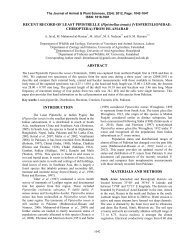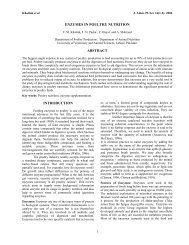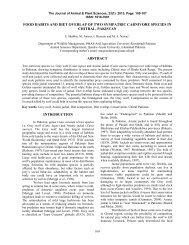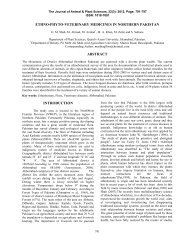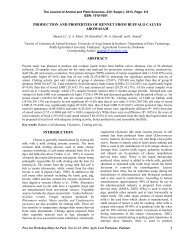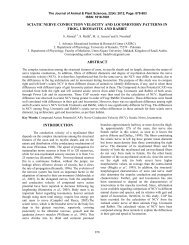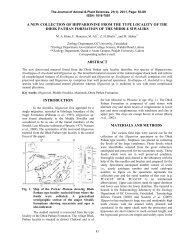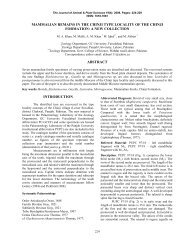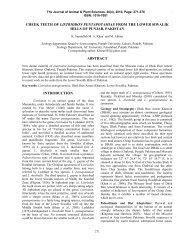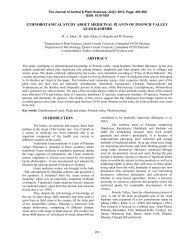using of factor analysis scores in multiple linear - Journal of Animal ...
using of factor analysis scores in multiple linear - Journal of Animal ...
using of factor analysis scores in multiple linear - Journal of Animal ...
Create successful ePaper yourself
Turn your PDF publications into a flip-book with our unique Google optimized e-Paper software.
et al. The <strong>Journal</strong> <strong>of</strong> <strong>Animal</strong> & Plant Sciences, 21(2): 2011, Page: J. 182-185 Anim. Plant Sci. 21(2):2011<br />
ISSN: 1018-7081<br />
USING OF FACTOR ANALYSIS SCORES IN MULTIPLE LINEAR REGRESSION<br />
MODEL FOR PREDICTION OF KERNEL WEIGHT IN ANKARA WALNUTS<br />
E. Sakar, S. Kesk<strong>in</strong> * and H. Unver **<br />
Deptt. <strong>of</strong> Horticulture, Faculty <strong>of</strong> Agriculture Sanluirfa, Turkey, * Deptt. <strong>of</strong> Biostatistics,<br />
Faculty <strong>of</strong> Medic<strong>in</strong>e Yuzuncu Yil University, Van, Turkey, ** Kalecik Vocational School, Ankara, Turkey<br />
Correspond<strong>in</strong>g author e-mail: ebru.sakar09@gmail.com<br />
ABSTRACT<br />
Kernel weight is important for plant breeders to select high productive plants. The determ<strong>in</strong>ation <strong>of</strong> relationships<br />
between kernel weight and some fruit-kernel characteristics may provide necessary <strong>in</strong>formation for plant breeders <strong>in</strong><br />
selection programs. In the present study, the relationships between kernel weight (KW) and 7 fruit-kernel characteristics:<br />
Fruit Length, (FL,), Fruit Width (FW) Fruit Height (FH) Fruit Weight (FWe) Shell Thickness (ST), Kernel Ratio (KR)<br />
and Filled-firm Kernel Raito (FKR,), were exam<strong>in</strong>ed by the comb<strong>in</strong>ation <strong>of</strong> <strong>factor</strong> and <strong>multiple</strong> l<strong>in</strong>ear regression<br />
analyses. Firstly, <strong>factor</strong> <strong>analysis</strong> was used to reduce large number <strong>of</strong> explanatory variables, to remove multicol<strong>in</strong>earty<br />
problems and to simplify the complex relationships among fruit-kernel characteristics. Then, 3 <strong>factor</strong>s hav<strong>in</strong>g Eigen<br />
values greater than 1 were selected as <strong>in</strong>dependent or explanatory variables and 3 <strong>factor</strong> <strong>scores</strong> coefficients were used for<br />
<strong>multiple</strong> l<strong>in</strong>ear regression <strong>analysis</strong>. As a result, it was found that three <strong>factor</strong>s formed by orig<strong>in</strong>al variables had<br />
significant effects on kernel weight and these <strong>factor</strong>s together have accounted for 85.9 % <strong>of</strong> variation <strong>in</strong> kernel weight.<br />
Key words: Walnut, communality, eigenvalues, varimax rotation, determ<strong>in</strong>ation coefficient<br />
INTRODUCTION<br />
The determ<strong>in</strong>ation <strong>of</strong> the relationships between<br />
kernel weight and fruit characteristics plays an important<br />
role <strong>in</strong> plant breed<strong>in</strong>g research. Multiple regression and<br />
<strong>factor</strong> analyses have been used to <strong>in</strong>terpret the<br />
multivariate relationships between kernel weight and<br />
fruit-kernel characteristics. This statistical tool is useful<br />
for predict<strong>in</strong>g assumed dependent variable. Factor<br />
<strong>analysis</strong> is applied to a s<strong>in</strong>gle set <strong>of</strong> variables to discover<br />
which variables are relatively <strong>in</strong>dependent <strong>of</strong> one another.<br />
It reduces many variables to a few <strong>factor</strong>s. It also<br />
produces several l<strong>in</strong>ear comb<strong>in</strong>ations <strong>of</strong> observed<br />
variables which are called as <strong>factor</strong>s. The <strong>factor</strong>s<br />
summarize the pattern <strong>of</strong> correlations <strong>in</strong> the observed<br />
data. Because there are normally fewer <strong>factor</strong>s than<br />
observed variables and because <strong>factor</strong> <strong>scores</strong> are nearly<br />
uncorrelated, use <strong>of</strong> <strong>factor</strong> <strong>scores</strong> <strong>in</strong> other analyses may<br />
be very helpful (Tabachnick and Fidell 2001).<br />
The ma<strong>in</strong> objective <strong>of</strong> the present study was;<br />
<strong>us<strong>in</strong>g</strong> 3 a multivariate statistical approach, <strong>factor</strong> <strong>analysis</strong>,<br />
to classify predictor variables accord<strong>in</strong>g to<br />
<strong>in</strong>terrelationships and to predict kernel weight <strong>in</strong> Ankara<br />
walnuts. For this purpose, <strong>factor</strong> <strong>analysis</strong> <strong>scores</strong> <strong>of</strong> 7<br />
fruit-kernel characteristics were used as <strong>in</strong>dependent<br />
variables <strong>in</strong> <strong>multiple</strong> l<strong>in</strong>ear regression model for<br />
prediction <strong>of</strong> kernel weight.<br />
182<br />
MATERIALS AND METHODS<br />
Data on characteristics: Fruit Length, (FL), Fruit<br />
Width (FW) Fruit Height (FH) Fruit Weight (FWe) Shell<br />
Thickness (ST), Kernel Weight (KW), Kernel Ratio (KR)<br />
and Filled-firm Kernel Raito (FKR), were collected from<br />
365 Ankara walnut samples.<br />
Statistical <strong>analysis</strong>: Kolmogorov-Simirnov normality<br />
test was applied for all variables. After normality test, it<br />
was determ<strong>in</strong>ed that all variables were normally<br />
distributed. Factor <strong>analysis</strong> was performed on 7 fruitkernel<br />
characteristics to rank their relative significance<br />
and to describe their <strong>in</strong>terrelation patterns to kernel<br />
weight.<br />
Factor <strong>analysis</strong>: For the <strong>factor</strong> <strong>analysis</strong>, basic <strong>factor</strong><br />
<strong>analysis</strong> equation can be represented <strong>in</strong> matrix form as:<br />
Zpx1 = �pxmFmx1 + �px1: where Z is a px1 vector <strong>of</strong><br />
variables, � is a pxm matrix <strong>of</strong> <strong>factor</strong> load<strong>in</strong>gs F is a mx1<br />
vector <strong>of</strong> <strong>factor</strong>s and � is a px1 vector <strong>of</strong> error (unique or<br />
specific) <strong>factor</strong>s (Sharma, 1996). It will be assumed that<br />
<strong>factor</strong>s were not correlated with the error components.<br />
Because <strong>of</strong> differences <strong>in</strong> were the units <strong>of</strong> each variables<br />
used <strong>in</strong> <strong>factor</strong> <strong>analysis</strong>, variables were standardized and<br />
correlation matrix <strong>of</strong> variables was used to obta<strong>in</strong> Eigen<br />
values. Load<strong>in</strong>gs were correlation coefficients between<br />
variables and <strong>factor</strong>s. Varimax rotation was used to<br />
facilitate <strong>in</strong>terpretation <strong>of</strong> <strong>factor</strong> load<strong>in</strong>gs (L ik).<br />
Coefficients (C ik), were used to obta<strong>in</strong> <strong>factor</strong> <strong>scores</strong> for<br />
selected <strong>factor</strong>s. Factors with Eigen values greater than 1
et al. J. Anim. Plant Sci. 21(2):2011<br />
out <strong>of</strong> 8 <strong>factor</strong>s were employed <strong>in</strong> <strong>multiple</strong> regression<br />
<strong>analysis</strong> (Sharma , 1996; Tabachnick and Fidell, 2001;<br />
Johnson and Wichern, 2002).<br />
Multiple l<strong>in</strong>ear regression <strong>analysis</strong>: Score values <strong>of</strong><br />
selected <strong>factor</strong>s were considered as <strong>in</strong>dependent variables<br />
for predict<strong>in</strong>g kernel weight.<br />
The regression equation is presented as;<br />
KW = a + b1FS1 + b2FS2 + b3FS3 + e<br />
where ‘a’ is regression constant (its value is zero), ‘b 1’,<br />
‘b2’ and b3 are regression coefficients <strong>of</strong> Factor Scores<br />
(FS). FS is <strong>factor</strong> <strong>scores</strong> and e is the error term <strong>of</strong> the<br />
regression model. Regression coefficients were tested by<br />
<strong>us<strong>in</strong>g</strong> t test. Determ<strong>in</strong>ation coefficient (R 2 ) was used as<br />
predictive success criteria for regression model (Draper<br />
and Smith 1998). All data were analyzed <strong>us<strong>in</strong>g</strong><br />
MINITAB (ver:14) statistical pack age (Anonymous,<br />
2000).<br />
RESULTS AND DISCUSSION<br />
Descriptive statistics and Pearson correlation<br />
coefficients for all characteristics are presented <strong>in</strong> Table 1<br />
and Table 2, respectively. S<strong>in</strong>ce most <strong>of</strong> the correlation<br />
coefficients among variables were significant (P≤0.01 or<br />
P≤0.05). Correlation coefficients may be <strong>factor</strong>able.<br />
Factor <strong>analysis</strong> revealed that 3 <strong>of</strong> the 7 <strong>factor</strong>s<br />
have Eigen values greater than one and were selected as<br />
<strong>in</strong>dependent variables for <strong>multiple</strong> regression model<br />
(Tabachnick and Fidell, 2001; Johnson and Wichern,<br />
2002).<br />
Three selected <strong>factor</strong>s expla<strong>in</strong>ed 84.84 %<br />
(5.939/7) <strong>of</strong> the total variation <strong>of</strong> variables <strong>in</strong> <strong>factor</strong><br />
<strong>analysis</strong>. Furthermore, communality values for variables<br />
were high. For example, communality for FWe was<br />
94.0%, <strong>in</strong>dicat<strong>in</strong>g that 94.0% <strong>of</strong> the variance <strong>in</strong> FWe is<br />
accounted for by Factor 1, 2 and 3. The proportion <strong>of</strong><br />
variance <strong>in</strong> the set <strong>of</strong> variables accounted for by a <strong>factor</strong><br />
is the sum <strong>of</strong> square load<strong>in</strong>g for the <strong>factor</strong> (SSL)<br />
(variance <strong>of</strong> <strong>factor</strong>) divided by the number <strong>of</strong> variables (if<br />
rotation is orthogonal).<br />
The proportion <strong>of</strong> variance is (3.187/7) = 0.4552<br />
i.e for the first <strong>factor</strong>.45.52 % <strong>of</strong> the variance <strong>in</strong> the<br />
variables is accounted for by the first <strong>factor</strong>. The second<br />
and third <strong>factor</strong> accounts for 23.63 and 15.69 % <strong>of</strong> total<br />
variation, respectively. Because rotation is orthogonal,<br />
the three <strong>factor</strong>s together accounted for 85.84 % <strong>of</strong> the<br />
variances <strong>in</strong> variables. The proportion <strong>of</strong> variance <strong>in</strong> the<br />
solution accounted for by a <strong>factor</strong>, <strong>in</strong> other words the<br />
proportion <strong>of</strong> covariance, is the Sum <strong>of</strong> Load<strong>in</strong>gs for the<br />
<strong>factor</strong> divided by the sum <strong>of</strong> communalities.<br />
For the selected three Factors, <strong>factor</strong> load<strong>in</strong>g and<br />
<strong>factor</strong> score coefficients are presented <strong>in</strong> Table 3. After<br />
orthogonal rotation, the values <strong>of</strong> load<strong>in</strong>g are correlations<br />
between variables and correspond<strong>in</strong>g <strong>factor</strong>s. The bold<br />
marked loads <strong>in</strong>dicate the highest correlations between<br />
183<br />
variables and correspond<strong>in</strong>g <strong>factor</strong>s. The greater load<strong>in</strong>g,<br />
the more the variables is pure measure <strong>of</strong> <strong>factor</strong>. For<br />
<strong>in</strong>stance, FL, FW, FH and FWe which showed the highest<br />
correlation with Factor 1 were considered as a group.<br />
Similarly, <strong>factor</strong> 3 showed highest correlation with only<br />
FKR.<br />
The highest values <strong>of</strong> communalities <strong>in</strong>dicated<br />
that the variances <strong>of</strong> variables were efficiently reflected<br />
<strong>in</strong> <strong>multiple</strong> regression <strong>analysis</strong>. All the 7 variables were<br />
<strong>in</strong>cluded <strong>in</strong> the three selected <strong>factor</strong>s. But only some <strong>of</strong><br />
variables possessed high loads with<strong>in</strong> each <strong>factor</strong>. FL,<br />
FW, FH and FWe possessed the highest loads <strong>in</strong> Factor 1,<br />
KR and ST <strong>in</strong> Factor 2, while FKR <strong>in</strong> Factor 3. Factors<br />
were <strong>in</strong>terpreted from the variables that werehighly<br />
correlated with them. Thus, the first <strong>factor</strong> primarily has<br />
Fruit measurements; the second <strong>factor</strong> has primarily<br />
Kernel and Shell measurements while the third <strong>factor</strong> had<br />
only FKR. For <strong>factor</strong> 1, samples which scored high fruit<br />
measurements tended to assign high value to FL, FW, FH<br />
and FWe.<br />
Factor score coefficients <strong>in</strong> Table 3 were used to<br />
obta<strong>in</strong> Factor score values. Factor score values for<br />
selected three <strong>factor</strong>s were used as <strong>in</strong>dependent variables<br />
<strong>in</strong> <strong>multiple</strong> l<strong>in</strong>ear regression <strong>analysis</strong> to determ<strong>in</strong>e<br />
significant <strong>factor</strong>s for kernel weight. All <strong>of</strong> the selected<br />
<strong>factor</strong>s (Factor 1, 2 and 3) were found to have significant<br />
l<strong>in</strong>ear relationships with kernel weight (p≤0.01). The 85.9<br />
% <strong>of</strong> variance <strong>in</strong> kernel weight was expla<strong>in</strong>ed by Factor<br />
1, 2 and 3 (Table-4).<br />
As seen from Table 4, all three <strong>factor</strong>s had<br />
positive and significant effect on kernel weight. Thus,<br />
kernel weight would to <strong>in</strong>crease when the values <strong>of</strong><br />
Factors <strong>scores</strong> <strong>in</strong>crease. Increase <strong>in</strong> significant variables<br />
<strong>in</strong> Factor 1, namely, FL, FW, FH and FWe <strong>in</strong>crease <strong>in</strong><br />
kernel weight. Similarly, <strong>in</strong>creas<strong>in</strong>g <strong>in</strong> Factor results <strong>in</strong> 3<br />
<strong>in</strong>creases kernel weight. On the other hand, an <strong>in</strong>crease <strong>in</strong><br />
significant variables <strong>in</strong> <strong>factor</strong> 2 <strong>scores</strong>, <strong>in</strong>directly<br />
<strong>in</strong>creases <strong>of</strong> KR and decreases ST would br<strong>in</strong>g an<br />
<strong>in</strong>crease <strong>in</strong> kernel weight.<br />
There is no study <strong>in</strong>cluded the same variable and<br />
statistical model as <strong>in</strong> our study. Therefore the results<br />
were discussed with <strong>in</strong>directly related studies. Sen (1983)<br />
po<strong>in</strong>ted out that correlation coefficients between FW and<br />
KR as well as between FW and KR were very high <strong>in</strong><br />
walnut. In addition, Sen (1985) stated that there is high<br />
significant correlation between KW and FL. Akça and<br />
Sen (1992) underl<strong>in</strong>ed that there were statistically<br />
significant correlations between KW and FL, FW, KR.<br />
Firouz and Bayazid (2003) <strong>in</strong>dicated that t he<br />
correlation between average small diameter and average<br />
seed weight, kernel weight and percentage, shell weight<br />
was positive and significant. The correlation between<br />
average seed weight, and average kernel weight and<br />
percentage, shell weight and thickness was also positive<br />
and significant. There were significant and positive<br />
correlations between average kernel weight and average
et al. J. Anim. Plant Sci. 21(2):2011<br />
shell weight and kernel percentage. The correlation<br />
between average shell weight and average shell thickness<br />
was significant and positive, whereas its correlation with<br />
average kernel percentage was significant and negative.<br />
The results <strong>of</strong> this study are largely <strong>in</strong> agreement<br />
with those <strong>of</strong> previous studies. Yang et al. (2001)<br />
determ<strong>in</strong>ed nut width, average nut weight, nut shell<br />
thickness, nut kernel percent age, per kernel weight, total<br />
fat content <strong>of</strong> kernel, total prote<strong>in</strong> content and kernel<br />
yield per m 2 tree-crown projection area by pr<strong>in</strong>cipal<br />
component <strong>analysis</strong>. Accord<strong>in</strong>g to more than 86.29% <strong>of</strong><br />
the cumulative variance proportion, the results proposed<br />
four pr<strong>in</strong>cipal components and its function equations<br />
which reflected the ma<strong>in</strong> economic characters <strong>of</strong> walnut.<br />
In the present study three <strong>factor</strong>s together have accounted<br />
for 84.84 % <strong>of</strong> variation <strong>in</strong> kernel weight.<br />
184<br />
Table 1. Descriptive statistics for fruit-kernel<br />
characteristics<br />
Mean SE M<strong>in</strong>i. Maxi.<br />
Fruit Length ( FL. mm) 35.679 0.226 26.52 49.85<br />
Fruit width (FW. mm) 29.549 0.151 22.39 39.29<br />
Fruit height (FH. mm) 30.975 0.173 23.17 44.40<br />
Fruit weight (FWe. g) 10.032 0.136 4.3 20.2<br />
Kernel weight (KW. g) 4.630 0.063 1.9 8.6<br />
Kernel Ratio (KR. %) 46.450 0.341 2.86 70.16<br />
Shell Thickness (ST.<br />
1.407 0.013 0.69 2.17<br />
mm)<br />
Table 2. Pearson correlation coefficients among all characteristics<br />
Filled-firm Kernel<br />
Raito (FKR. %)<br />
89.950 0.916 0 100<br />
FL FW FH FWe KW KR ST FKR<br />
FL 1<br />
FW 0.661** 1<br />
FH 0.575** 0.879** 1<br />
FWe 0.705** 0.805** 0.823** 1<br />
KW 0.654** 0.793** 0.796** 0.867** 1<br />
KR -0.106* -0.046 -0.043 -0.218** 0.246** 1<br />
ST 0.146** 0.062 0.120* 0.420** 0.080 -0.576** 1<br />
FKR 0.155** 0.140** 0.169** 0.382** 0.368** 0.030 0.132* 1<br />
*: p
et al. J. Anim. Plant Sci. 21(2):2011<br />
variables. In addition, this approach gets easy do<strong>in</strong>g<br />
<strong>multiple</strong> regression models by reduc<strong>in</strong>g large number <strong>of</strong><br />
variables and <strong>in</strong>terpretation <strong>of</strong> <strong>multiple</strong> regression model<br />
results by remov<strong>in</strong>g <strong>in</strong>direct effect <strong>of</strong> related explanatory<br />
variables. The present study is one <strong>of</strong> the pioneer and<br />
studies and hopefully, will be useful for future studies <strong>of</strong><br />
similar nature.<br />
REFERENCES<br />
Akça, Y. and S. M., Sen (1992). Cevizlerde (Juglans<br />
regia L.) Onemli Seleksiyon Kriterleri arasındaki<br />
Iliskiler. YY Ü. ZF Derg., 2(2): 67- 75.<br />
Anonymous (2000). MINITAB Statistical s<strong>of</strong>tware,<br />
M<strong>in</strong>itab Inc. USA.<br />
Draper, N. R. and H. Smith (1998). Applied Regression<br />
Analysis, John Wiley and Sons, Inc., New<br />
York, (USA). 706 pp<br />
Firouz, M., and Y. Bayazid (2003) Evaluatıon <strong>of</strong><br />
Walnut's Seed Propertıes <strong>in</strong> Kurdestan Prov<strong>in</strong>ce.<br />
Iranian J. Forest and Poplar Res. 11(4): 565-584.<br />
Johnson, R. A. and D.W Wichern (2002). Applied<br />
Multivariate Statistical Analysis. Prentice Hall,<br />
upper Saddle River, New Jersey, (USA). 766 pp<br />
185<br />
Sen, S. M., (1983). Cevizlerde Önemli Meyve Kalite<br />
Faktörleri Arasındaki _liskiler. II. Meyve<br />
Agırlıgı ile Kabuk Kalınlıgı ve Kabuk Kırılması<br />
Arasındaki _liskiler. Atatürk Üniv. Ziraat Fak.<br />
Derg., 14(3): 17-28,<br />
Sen, S. M., (1985). Cevizlerde Kabuk Kalınlıgı, Kabuk<br />
Kırılma Direnci, Kabukta Yapısma ve Kabuk<br />
Dik<strong>in</strong>e Kırılma Direnci ile Diger Bazı Kalite<br />
Faktörleri Arasındaki _liskiler. Doga Bilim<br />
Derg., 9(1): 10-24.<br />
Sharma, S. (1996). Applied Multivariate Techniques,<br />
John Wiley and Sons, Inc., New York, (USA).<br />
493 pp<br />
Tabachnick, B. G. and L. S Fidell (2001). Us<strong>in</strong>g<br />
Multivariate Statistics. Allyn and Bacon A<br />
Pearson Education Company Boston, (USA).<br />
966 pp.<br />
Yang, J., B. W. Guo and G, Q. Zhang (2001). The studies<br />
<strong>of</strong> pr<strong>in</strong>cipal component <strong>analysis</strong> on the ma<strong>in</strong><br />
economic character and superior variety<br />
selection <strong>of</strong> walnut. J. Agri. University <strong>of</strong> Hebei.<br />
DOI: cnki: ISSN:1000-1573.0.2001-04-012.



